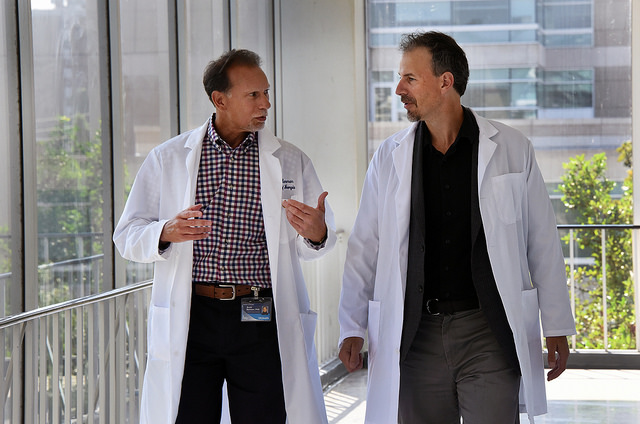Scientists Using $2.2M Grant to Study Protein Believed to Cause Pulmonary Hypertension

Dr. Scott Barman, left, and Dr. David Fulton of the Medical College of Georgia at Augusta University. (Credit: Phil Jones)
Researchers at the Medical College of Georgia at Augusta University are exploring how a protein, found in high levels in patients with pulmonary hypertension, might drive disease, while at the same time investigating potential treatments targeting the factor.
The protein that caught the attention of Dr. David Fulton — director of the Vascular Biology Center at the Medical College, and Dr. Scott Barman, a pulmonary vascular biologist in the Department of Pharmacology and Toxicology — is called Galectin-3, often shortened to gal-3.
Previously, the two researchers showed that in both humans and animal models of the disease, gal-3 is particularly high in the middle layer of arteries known as the media, composed mainly of smooth muscle cells that provide blood vessels with the flexibility they need to work properly. The team will continue studying the protein using a $2.2 million grant from the National Institutes of Health (NIH).
The researchers found that increasing the concentration of gal-3 in smooth muscle cells cultured in the lab caused the cells to start multiplying abnormally. Blocking the protein’s production, in contrast, prevented such rapid production.
They believe the deviant behavior of the smooth muscles may trigger disease development. “Excessive constriction makes the vessels small in the first place; inflammation and remodeling make it a permanent anatomical alteration,” Dr. Barman said in a press release, suggesting that the increased pressure in the constricted vessels start processes that lead to irreversible tissue damage, an idea Dr. Fulton supports.
“The lung circulation is a high-capacity, low-resistance environment. Any increase in resistance to blood flow is really damaging,” he said.
In a collaboration with Galectin Therapeutics, the team also studied GR-MD-02 — a drug blocking gal-3 — exploring if it could halt or even reverse the disease. The drug is currently being studied in humans, and recent findings presented at the American Thoracic Society International Conference this year showed that the drug can reverse early disease.
Since changes in blood vessels are often at a more advanced stage once patients start experiencing symptoms, the researchers are exploring ways of treating those later stages.
In addition to finding a way to block gal-3 from causing the remodeling of blood vessels seen in pulmonary hypertension, the two scientists also want to find out why the cells start producing high levels of gal-3 in the first place.








